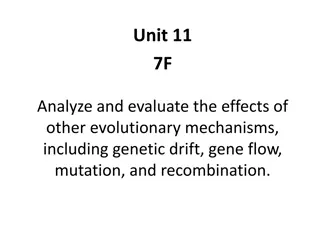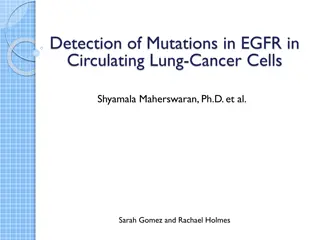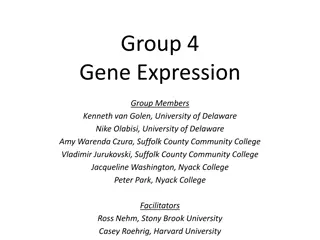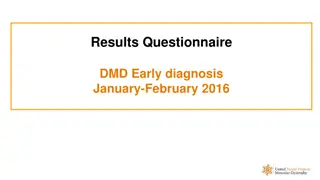Wiedemann-Steiner Syndrome Data Analysis and Progress Report - November 2023
This report provides insights into the enrollment, survey completion, KMT2A mutation types, reported issues, completion rates of relevant surveys, and symptoms in individuals diagnosed with Wiedemann-Steiner Syndrome. With a global perspective, the data highlights various domains of concern, offerin
1 views • 36 slides
Understanding Wolfram Syndrome: Symptoms and Implications
Wolfram Syndrome, also known as DIDMOAD, is a rare genetic disorder affecting about 1 in 160,000-770,000 people worldwide. It is characterized by the presence of Diabetes Insipidus, Diabetes Mellitus, Optic Atrophy, and Deafness. The primary genetic mutation in the WFS1 gene leads to various symptom
0 views • 22 slides
Prevalence of KIT D816V Mutation in Patients with Systemic Mast Cell Activation
This study presents findings from the PROSPECTOR clinical trial on the prevalence of the KIT D816V mutation in the peripheral blood of patients with systemic mast cell activation. The study involves multiple centers globally and sheds light on the significance of this mutation in systemic mastocytos
5 views • 14 slides
Understanding Inheritance of Traits Through Blue Skin Case Study
Assessing genetic inheritance and mutations using a case study of a boy with blue skin. The scenario highlights how genes control traits, the random assortment of chromosomes in offspring, and the impact of mutations on protein function. Students analyze karyotypes to infer genetic differences betwe
0 views • 6 slides
Understanding Evolution by Natural Selection
Explore the concepts of species, mutation, Darwin's theory of evolution, and the role of genetic variation through mutations. Learn how mutations can lead to rapid changes in species and why a wider variety of genes in a gene pool benefits a population. Delve into the effects of mutations on individ
0 views • 15 slides
Understanding Mutations in Biology
A mutation in biology refers to changes in the nucleotide sequence of an organism's genome. These alterations can either be harmful, leading to conditions like cancer, or beneficial, such as providing antibiotic resistance. Mutations can occur in somatic cells or gametes, affecting both the individu
1 views • 18 slides
Understanding Mutation and Polyploidy in Genetics
Mutation is a sudden hereditary change in an organism's genetic makeup, leading to variations in offspring. This article delves into the history, types, and causes of mutations, featuring significant discoveries by scientists like De Vries and Morgan. It also explores the concept of spontaneous muta
0 views • 50 slides
Improving Microbial Productivity and Characteristics for Industrial Applications
Efforts to enhance the productivity of natural isolates for commercial products involve genetic modifications through mutation, genetic recombination, and genetic engineering techniques. Desired characteristics include genetic stability, efficient production, versatility in carbon sources, and ease
1 views • 25 slides
Understanding Atypical Patterns of Inheritance in Genetics
Explore atypical modes of inheritance such as codominant traits, pseudodominant inheritance, mitochondrial inheritance, anticipation, pleiotropy, variable expressivity, heterogeneity, new mutation, and complex traits in genetics. Learn about codominance, pseudodominance, and atypical presentation of
0 views • 26 slides
Insights into Biotechnology: Concepts and Applications
Biotechnology involves the application of scientific and engineering principles to utilize biological agents for producing goods and services. The field encompasses processes like upstream processing, fermentation, and downstream processing to create valuable compounds. Initially, efforts focused on
0 views • 22 slides
Understanding Gene Duplication, Mutation, and Read Mapping in Molecular Evolution
This presentation delves into the intricate concepts of gene duplication, DNA mutation, and read mapping in the context of molecular evolution. It explains the various types of mutations, the significance of gene duplication in generating new genetic material, and the process of read mapping to alig
0 views • 19 slides
Introduction to Differential Evolution Metaheuristic Algorithm
Differential Evolution (DE) is a vector-based metaheuristic algorithm known for its good convergence properties. Developed by Storn and Price in the late 1990s, DE operates on real numbers as solution strings, making encoding and decoding unnecessary. This algorithm utilizes vectors for mutation and
8 views • 18 slides
Yelamos Family and Colon Cancer Research Overview
The Yelamos Family, immigrants from Guatemala, unknowingly carry a genetic mutation putting them at high risk for colon cancer. This research delves into the impact of genetic predisposition and lifestyle changes on their health. The proposed family visit to a medical school aims to educate and rais
0 views • 13 slides
Comprehensive Analysis of Gene Expression and Regulatory Potential Through eCLIP Profiles
Explore a thorough examination of gene expression and regulatory potential using eCLIP profiles, shRNA, RNA-Seq, secondary structure conservation, and prioritized genes. Uncover insights on users' variants, regulator scores, nucleotide scores, RBP rank lists, mutation burden, and more. Dive deep int
3 views • 10 slides
Familial Colorectal Cancer Syndromes: Genetic Profiles and Clinical Presentations
These pedigrees depict familial colorectal cancer syndromes in Ashkenazi and Iraqi Jews, showcasing early-onset MMR-proficient CRC cases linked to mutations in POLD1 and POLE genes. The pedigrees detail various cancer diagnoses, mutation carrier statuses, and ages of onset across multiple generation
0 views • 5 slides
Monogenetic Disorders in Noriker Horses: Implications for Conservation Breeding Programs
This study explores monogenetic disorders, specifically PSSM Type1, in Noriker horses, highlighting the impact of GYS1 gene mutation on breeding practices. The research delves into carrier frequencies across diverse horse breeds and emphasizes the importance of genetic screening in conservation bree
1 views • 18 slides
NCI-MATCH Trial Interim Analysis Results and Status Update
NCI-MATCH is a groundbreaking clinical trial aiming to match tumor gene alterations with targeted therapies. The interim analysis results revealed impressive patient enrollment and site participation exceeding expectations. Despite challenges with pausing new patient registrations for the analysis,
0 views • 26 slides
Understanding Differential Evolution: An Overview of the DE Algorithm
Differential Evolution (DE) is an Evolutionary Algorithm (EA) proposed for continuous function optimization. It uses vector differences to perturb the population, deviating from traditional crossover and mutation methods. DE involves mutation, perturbation, and various mutation schemes like DE/rand/
0 views • 20 slides
Understanding Chromosomes: Key Components, Functions, and Significance
Chromosomes, essential in mitosis and meiosis, are condensed forms of DNA vital for heredity, mutation, and evolution. Learn about their structure, role in inheritance, and impact on species development through historical discoveries. Discover the importance of chromosome sets and genomes in gametic
0 views • 38 slides
Genetic Algorithm for Attribute Selection in Data Mining
Genetic algorithm (GA) is a powerful method for attribute selection in data mining as it efficiently explores numerous attribute combinations. By choosing the most important features and ignoring the rest, GA can enhance the data analysis process through methods like feature extraction and artificia
0 views • 41 slides
Exploring Evolutionary Mechanisms: Genetic Drift, Gene Flow, Mutation, and Recombination
Delve into the effects of evolutionary mechanisms such as genetic drift, gene flow, mutation, and recombination in populations. Understand how changes in allele frequencies occur due to various factors like natural disasters and the bottleneck effect, impacting the gene pool and future generations.
1 views • 32 slides
Understanding Transition Bias and Substitution Models in Genetics
Transition bias and substitution models, explored by Xuhua Xia, delve into the concepts of transitions and transversions in genetic mutations, the causes of transition bias, the ubiquitous nature of transition bias in invertebrate and vertebrate genes, the mitochondrial genetic code, and RNA seconda
1 views • 25 slides
Understanding Mutation Testing in Software Testing
Mutation testing involves creating mutant programs by modifying the original program under test to find effective test cases. The process aims to identify weaknesses in test suites by evaluating how well they can detect changes in the program's behavior. Different types of mutants exist, such as dea
0 views • 22 slides
Understanding Evolutionary Algorithms in Computer Science
Evolutionary algorithms, particularly genetic algorithms, simulate natural evolution to optimize parameters and discover new solutions. By creating genomes representing potential solutions and using genetic operators like mutation and crossover, these algorithms populate a search space, conduct loca
0 views • 33 slides
Understanding Evolution: Natural Selection and Genetic Variation
Change in genetic makeup over time is evolution. Natural selection, driven by competition for resources, leads to differential survival and reproductive success. Genetic variation, mutation, and adaptation play roles in this process. Environmental changes influence evolutionary rate and direction. H
0 views • 20 slides
Understanding Evolutionary Mechanisms in Pepper Populations
Explore the evolutionary mechanisms of natural selection and genetic drift through a fun activity involving a wild chili pepper population. Witness how chemical defense affects the survival and reproduction of pepper plants against herbivores and pathogens. Learn about the concepts of mutation, gene
0 views • 23 slides
Detection of Mutations in EGFR in Circulating Lung Cancer Cells: Study on SARMS Assay and CTC-Chip
This study by Shyamala Maherswaran, Ph.D., and team focuses on characterizing mutations in EGFR in circulating tumor cells using SARMS assay and CTC-chip. The research investigates the effectiveness of these non-invasive methods in analyzing tumors and explores the role of the T790M mutation in resp
0 views • 12 slides
Treatment Strategies for Recurrent Venous Thromboembolism in Factor V Leiden Patients
This presentation discusses the treatment options for recurrent venous thromboembolism in patients with Factor V Leiden mutation. It explores the pathophysiology, epidemiology, and diagnosis criteria for Factor V Leiden, reviews failed anticoagulation history, and suggests outpatient anticoagulation
0 views • 31 slides
Understanding Computational Biology: Proteins, DNA, RNA, Genetics, and Evolution
Computational Biology combines computational methods with molecular biology to solve biological problems. Explore topics like proteins, DNA, RNA, and genetics, learning about amino acids, nucleotides, and the genetic code. Understand the evolutionary processes of mutation and natural selection.
0 views • 21 slides
Evolutionary Dynamics of Cooperation by Martin Nowak at Harvard University
Explore the evolution of cooperation from the origins of life to human behavior with a focus on mechanisms such as natural selection, direct reciprocity, and the Prisoner's Dilemma. Learn how populations evolve through mutation, selection, and the interplay between cooperation and defection in vario
0 views • 50 slides
Understanding Sickle Cell Anemia: Causes, Symptoms, and Pathophysiology
Sickle cell anemia is an inherited disorder affecting red blood cells' shape, leading to decreased oxygen delivery and various symptoms like fatigue, pain episodes, and more. The condition arises from a genetic mutation affecting hemoglobin production. Individuals with sickle cell trait may not disp
0 views • 7 slides
Understanding Compositional Assemblies and Quasispecies Model
Compositional assemblies exhibit behavior similar to the quasispecies model, as explored by Renan Gross, Omer Markovitch, and Doron Lancet at the Weizmann Institute of Science. This model provides insight into population dynamics and the replication processes of genotypes within environments, sheddi
0 views • 35 slides
Evolutionary Insights from Mitochondrial DNA Analysis in Primates
Studies by Ferris et al. and Cann et al. utilized mitochondrial DNA analysis to understand the evolutionary relationships among apes and humans. The application of parsimony to restriction sites revealed the closest genetic ties between species and proposed an African origin for human colonization.
0 views • 13 slides
Understanding Population Genetics: Mutations, Variability, and Evolution
Explore the fascinating world of population genetics, covering key concepts like the history of population genetics, mutation types, measurement of variability, and mutation rates. Delve into the diverse mutations such as substitutions, insertions, deletions, and duplications, along with how these v
0 views • 47 slides
Introduction to Gene Expression: Basic Concepts in Transcription and Translation
Explore the foundational concepts of gene expression including transcription and translation processes, genetic mutations, and their impact on protein structure and function. Learn to define genes, outline central dogma steps, and understand the relationships among DNA, genes, RNA, and proteins. Pra
0 views • 39 slides
Insights from DMD Early Diagnosis Questionnaire - January & February 2016
Detailed findings from a questionnaire on Duchenne Muscular Dystrophy (DMD) early diagnosis in various countries: average age of DMD diagnosis, medical programs for young children, first person to detect issues, duration between concerns and diagnosis, diagnosis makers, parental information receptio
0 views • 11 slides
The LaPerm Cat: A Unique Feline Breed
The LaPerm cat is a distinctive breed known for its curly coat, originating from barn cats in Oregon in the 1980s due to a spontaneous mutation. It comes in both longhair and shorthair varieties, with all coat and eye colors accepted. This medium-sized cat has a modified wedge-shaped head, high chee
0 views • 22 slides
Understanding Mutation Breeding in Crop Plants
Mutation breeding involves inducing heritable changes in crop plants through mutations, leading to genetic improvements for economic traits. This method is valuable when desired variability is lacking, for correcting genetic defects, overcoming linkage issues between desirable and undesirable traits
0 views • 22 slides
Investigating the Role of Amino Acid 381 in BK Channel Clustering
The study explores the significance of amino acid 381 in the function of dystrophin to localize SLO-1 in C. elegans. By utilizing the T381I mutation, the research aims to determine whether a SLO-1 BK channel with this mutation exhibits a clustered or non-clustered phenotype. Proposed methods involve
0 views • 17 slides
Insights into Evolution, Natural Selection, and Cancer Mutation
Explore the concepts of evolution, natural selection, and cancer mutation through detailed descriptions and illustrations. Learn about the evolutionary processes that drive diversity in biological populations, the role of natural selection in shaping traits, and the mechanisms behind cancer developm
0 views • 20 slides







































